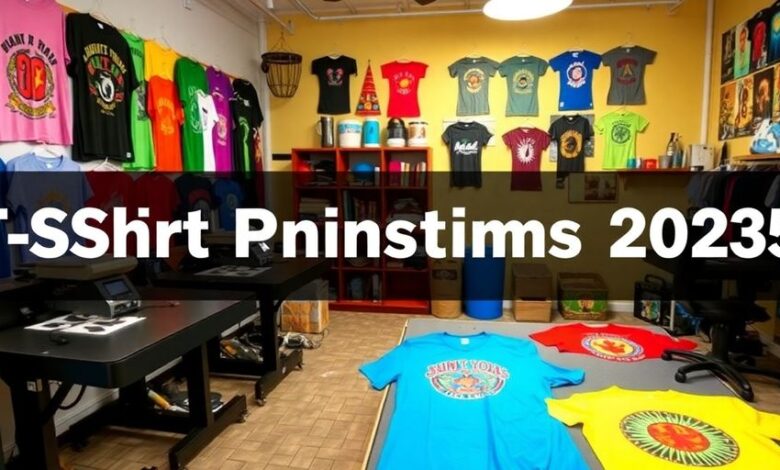
Starting a t-shirt printing business can be an exciting venture, especially in 2025 where the market is booming. With the right approach, anyone can dive into this creative industry and make a profit. This guide will walk you through the essential steps to get your t-shirt printing business off the ground, from identifying your target audience to managing your finances. Let’s break it down into manageable pieces so you can focus on what really matters: creating awesome designs and connecting with customers.
Key Takeaways
- Identify your target market to create designs that appeal to them.
- Choose a printing method that fits your budget and production needs.
- Utilize e-commerce platforms to set up your online store easily.
- Leverage social media and influencers for effective marketing.
- Keep track of your expenses and pricing to ensure profitability.
Identifying Your Target Market
Before you even think about designs or printing methods, you need to figure out who you’re selling to. It sounds obvious, but a lot of people skip this step and then wonder why their shirts aren’t flying off the shelves. Knowing your audience is the most important step in starting a t-shirt business.
Understanding Customer Demographics
Okay, so you have a general idea of who you want to sell to. Great! Now it’s time to get specific. We’re talking age, gender, location, income, interests, education – the whole shebang. The more you know, the better you can tailor your designs and marketing efforts. For example, are you targeting college students? Then you’ll want to focus on trendy designs and affordable prices. Are you targeting middle-aged professionals? Then you might want to focus on quality materials and sophisticated designs. Dig into the data! Use surveys, social media analytics, and even just plain old observation to gather information. This will help you understand your target audience better.
Analyzing Market Trends
What’s hot right now? What’s not? You need to stay on top of the latest trends in the t-shirt market. This doesn’t mean blindly following every fad, but it does mean being aware of what people are buying and what they’re interested in. Check out what’s selling well on sites like Etsy and Amazon. Look at what influencers are wearing. Pay attention to what’s trending on social media. Use tools like Google Trends to see what people are searching for. By analyzing market trends, you can identify opportunities to create designs that are both unique and in demand. This will help you to convert your t-shirt designs into sales.
Defining Your Niche
This is where things get really interesting. Instead of trying to appeal to everyone, focus on a specific niche market. Think of it this way: it’s better to be a big fish in a small pond than a small fish in a big ocean. What are you passionate about? What are you good at? What problems can you solve with your t-shirt designs? Maybe you’re into gaming, environmentalism, or a specific type of music. Whatever it is, find a niche that aligns with your interests and expertise. This will make it easier to create authentic designs and connect with your target audience. For example, instead of just selling t-shirts to “women,” sell t-shirts to “women who love hiking.” This will help you to narrow down your focus and build customer loyalty.
Choosing The Right Printing Method

Choosing the right printing method is a critical decision that will impact the quality, cost, and overall appeal of your t-shirts. It’s not just about slapping a design on a shirt; it’s about understanding the nuances of each technique and how they align with your designs, target market, and budget. Let’s explore the options.
Overview of Printing Techniques
There are several printing techniques available, each with its own set of advantages and disadvantages. Understanding these differences is key to making an informed decision. Here’s a quick rundown:
- Screen Printing: A classic method that involves pressing ink through a stenciled mesh screen. It’s durable and cost-effective for bulk orders.
- Direct-to-Garment (DTG): This method uses inkjet technology to print directly onto the fabric. It’s ideal for complex, full-color designs and smaller print runs.
- Heat Transfer: Designs are printed onto special paper and then transferred to the fabric using heat and pressure. It’s a good option for simple designs and personalized items.
- Sublimation: This technique uses heat to transfer dye onto synthetic fabrics, resulting in vibrant, permanent prints. It’s best suited for polyester materials.
Pros and Cons of Each Method
Each printing method has its strengths and weaknesses. Let’s take a closer look:
| Printing Method | Pros Instructing DTG printing manufacturer is a good idea.
Choosing the right printing method is a big deal. It’s about more than just getting ink on fabric; it’s about making a statement and delivering a product that you’re proud of. Consider your options carefully, weigh the pros and cons, and don’t be afraid to experiment until you find the perfect fit.
Selecting a Reliable Supplier
Finding a reliable supplier is just as important as choosing the right printing method. You need a partner who can deliver quality prints on time and within budget. Here are some tips for finding a good supplier:
- Do your research: Look for suppliers with a proven track record and positive reviews.
- Request samples: Always ask for samples before committing to a large order. This will allow you to assess the print quality and fabric. Ordering product samples ensures the t-shirt design and fabric quality match your expectations.
- Consider turnaround time: Make sure the supplier can meet your deadlines. Starting a T-shirt printing business requires you to manage time effectively.
- Compare prices: Get quotes from multiple suppliers to ensure you’re getting a fair price.
- Check their equipment: Ask about the type of printing equipment they use. Modern equipment often translates to better quality and faster turnaround times.
- Ask about their sustainability practices: If eco-friendliness is important to you, choose a supplier who uses sustainable materials and practices. 53% of customers prefer eco-friendly options and ethical sourcing practices.
Designing Your T-Shirt Collection
Creating Unique Designs
Okay, so you’re ready to make some shirts. Awesome! This is where the fun really begins. Your designs are what will grab people’s attention and make them want to buy your stuff. Think about what makes your brand different. What’s your vibe? Are you funny, serious, edgy, or something else entirely? Let that shine through in your designs.
- Consider your target audience. What are they into? What kind of graphics or slogans would they like?
- Don’t be afraid to experiment. Try different styles, colors, and layouts.
- Look at what other brands are doing, but don’t copy them. Find your own unique voice.
Remember, your designs are a reflection of your brand. Make sure they’re something you’re proud of and that accurately represents what you’re trying to sell.
Using Design Software
Alright, so you’ve got some killer ideas. Now it’s time to bring them to life. You’ve got a few options here. If you’re already a design whiz, you can use professional software like Adobe Photoshop or Illustrator. But if you’re like most people, you might want to start with something a little more user-friendly. There are tons of online tools out there that are specifically designed for t-shirt design. These often have drag-and-drop interfaces and pre-made graphics that you can use to get started.
- Canva is a popular choice for beginners. It’s easy to use and has a ton of templates.
- GIMP is a free, open-source alternative to Photoshop.
- Inkscape is a free, open-source alternative to Illustrator.
Incorporating Customer Feedback
Don’t just assume you know what your customers want. Ask them! Get their input on your designs before you even start printing. This can save you a lot of time and money in the long run. Post your designs on social media and ask for feedback. Run polls to see which designs are most popular. You could even offer a discount to customers who provide helpful feedback. This is a great way to build a community around your brand and make your customers feel like they’re part of the process. Consider using mockups to visualize your designs on actual shirts. This helps people see what the final product will look like. You can find plenty of free and paid mockup templates online. Also, think about running contests or giveaways to get people excited about your designs. This is a great way to generate buzz and get people talking about your brand. Remember to analyze market trends to stay ahead of the curve.
Setting Up Your Online Store
So, you’ve got your designs ready and you’re itching to start selling? Awesome! Now comes the part where you actually set up shop online. Don’t worry, it’s not as scary as it sounds. Let’s break it down.
Choosing an E-Commerce Platform
Okay, first things first: where are you going to sell your shirts? You’ve got options! Think of an e-commerce platform like the foundation of your entire online business. You could go with a big name like Shopify, which is super user-friendly and has tons of apps to help you manage everything. Or, if you’re a bit more tech-savvy, maybe WooCommerce (which works with WordPress) is more your style. There’s also BigCommerce, which is great if you’re planning on scaling up quickly. Each has its pros and cons, so do a little digging to see which one fits your needs and budget.
Here’s a quick rundown:
- Shopify: Easy to use, lots of apps, good for beginners.
- WooCommerce: Flexible, customizable, requires some technical knowledge.
- BigCommerce: Scalable, powerful features, can be a bit pricier.
Designing Your Website
Alright, you’ve picked your platform. Now it’s time to make your store look good! Your website is your storefront, so you want it to be inviting and easy to navigate. Think about your brand’s vibe. Is it minimalist and modern? Or colorful and quirky? Choose a theme that reflects that. Make sure your product photos are high-quality and that your descriptions are clear and enticing. And for the love of all that is holy, make sure your site is mobile-friendly! Most people will be browsing on their phones, so if your site looks wonky on mobile, you’re going to lose sales. Don’t forget to set up a domain name that’s easy to remember and reflects your brand.
Optimizing for SEO
Okay, so you’ve got a beautiful website. Great! But what good is it if no one can find it? That’s where SEO (Search Engine Optimization) comes in. Basically, it’s all about making your site more visible in search engine results. Here are a few things you can do:
- Keyword Research: Figure out what words people are using to search for t-shirts like yours. Use those keywords in your product descriptions, page titles, and meta descriptions.
- Optimize Images: Make sure your image file names and alt text include relevant keywords.
- Build Backlinks: Get other websites to link to your site. This tells search engines that your site is trustworthy and authoritative.
SEO can seem intimidating, but it’s really just about making your site as user-friendly and informative as possible. The better your site is, the higher it will rank in search results.
Don’t forget to set up a simple checkout process to avoid losing customers at the last minute.
Marketing Your T-Shirt Business

Alright, you’ve got your designs, your printing method sorted, and your online store is looking sharp. Now comes the fun part: getting people to actually buy your t-shirts. Marketing can feel overwhelming, but breaking it down into manageable chunks makes it way less scary. Let’s dive in.
Utilizing Social Media
Social media is your best friend when you’re starting out. It’s free (mostly), and it lets you connect directly with potential customers. Think about where your target audience hangs out. Is it Instagram for visual appeal? Maybe TikTok for short, engaging videos? Or perhaps Facebook for a broader demographic? Pick one or two platforms to start, and really focus on creating great content. Don’t spread yourself too thin.
- Post regularly – consistency is key.
- Use relevant hashtags to increase visibility.
- Engage with your followers – respond to comments and messages.
Social media isn’t just about selling; it’s about building a community around your brand. Share behind-the-scenes glimpses, run contests, and ask for feedback. Make it fun and engaging, and people will be more likely to stick around.
Implementing Email Marketing
Email marketing might seem old-school, but it’s still incredibly effective. Start building an email list from day one. Offer a discount or freebie in exchange for signing up. Once you have a list, you can send out newsletters, announce new designs, and promote sales.
- Use an email marketing service like Mailchimp or ConvertKit.
- Segment your list to send targeted emails.
- Track your results to see what’s working and what’s not.
Think about offering free gift card codes to new subscribers to incentivize sign-ups. This can be a great way to grow your list quickly.
Collaborating with Influencers
Influencer marketing can be a game-changer, but it’s important to do your research. Find influencers who align with your brand and target audience. Don’t just look at follower count; look at engagement rate. A smaller influencer with a highly engaged audience might be more effective than a larger influencer with low engagement.
- Reach out to influencers with a personalized message.
- Offer them free t-shirts or a commission on sales.
- Track the results of your collaborations to see if they’re worth the investment.
Consider offering exclusive designs to influencers to help generate buzz and excitement around your brand.
Managing Finances and Pricing
Alright, so you’ve got designs, a printing method, and a store. Now comes the part that makes or breaks any business: money. Let’s talk about managing your finances and, most importantly, pricing your t-shirts so you actually make some cash. It’s not just about slapping a number on a shirt; it’s about understanding your costs, knowing your market, and figuring out how to stay competitive.
Calculating Costs and Expenses
First things first, you need to know exactly how much it costs to make and sell each t-shirt. This isn’t just the cost of the blank tee and the ink. Think about everything. Knowing your costs is the foundation of profitable pricing.
- Variable Costs: These change depending on how many shirts you sell. This includes the cost of the blank t-shirt itself, the printing cost (which can vary based on the design and printing method), and shipping expenses.
- Fixed Costs: These stay the same no matter how many shirts you sell. Think about your design software subscriptions, e-commerce platform fees, and any marketing costs you’re paying regularly.
- Hidden Costs: Don’t forget about things like packaging materials, electricity used for your equipment, and even the cost of your internet connection. These might seem small, but they add up!
It’s a good idea to create a spreadsheet to track all of these costs. Update it regularly as prices change. This will give you a clear picture of your expenses and help you make informed pricing decisions.
Setting Competitive Prices
Okay, you know your costs. Now, how do you actually price your shirts? There are a few different strategies you can use. It’s important to find the right balance between making a profit and attracting customers. You can also use Shopify Finance to help you manage your finances.
- Cost-Plus Pricing: This is the simplest method. You add up all your costs and then add a desired profit margin on top. For example, if a shirt costs you $10 to make, and you want a 50% profit margin, you’d price it at $15.
- Keystone Pricing: This involves simply doubling your wholesale cost to determine your retail price. It’s easy, but might not always be the best strategy.
- Value-Based Pricing: This is where you price your shirts based on what customers are willing to pay. If you have a really unique design or a strong brand, you might be able to charge more. Consider the perceived value your t-shirt offers the customer, considering factors like design, brand identity, and material quality.
- Competitive Pricing: Look at what your competitors are charging for similar shirts. You can price yours slightly higher if you think your shirts are better quality, or slightly lower to attract more customers. Analyze competitor pricing and adjust yours slightly higher or lower based on your value proposition.
Understanding Profit Margins
Profit margin is the percentage of revenue you keep after paying all your expenses. It’s a key indicator of your business’s financial health. A healthy profit margin means your business is sustainable.
Here’s a simple formula:
Profit Margin = (Revenue - Cost of Goods Sold) / Revenue * 100
For example, if you sell a shirt for $20 and it costs you $12 to make, your profit margin is 40% (($20 – $12) / $20 * 100). Aim for a profit margin that’s high enough to cover your fixed costs and leave you with a decent profit. Keep an eye on your analytics and reporting to see how your pricing affects your sales and profit margins. Don’t be afraid to experiment with different pricing strategies to find what works best for your business.
Legal Considerations for Your Business
Starting a t-shirt business is exciting, but don’t forget the legal stuff! It’s not the most glamorous part, but getting it right from the start can save you a lot of headaches later on. Let’s break down some key areas.
Registering Your Business
First things first, you need to make your business official. This usually involves registering your business name with your state or local government. The exact requirements vary, so check with your local authorities. You might need a business license or a resale license, especially if you’re buying shirts from a distributor without paying sales tax.
- Sole Proprietorship: Simplest form, you and the business are one and the same.
- Limited Liability Company (LLC): Offers some protection for your personal assets.
- Corporation: More complex, but can offer greater liability protection and tax benefits.
Choosing the right business structure is important, so do your research or talk to a professional.
Understanding Copyright and Trademarks
This is a big one! You can’t just slap any design on a t-shirt and sell it. You need to make sure you have the rights to use the images, logos, and text you’re using.
- Copyright protects original works of authorship, like designs and artwork.
- Trademarks protect brand names and logos.
- Using someone else’s copyrighted or trademarked material without permission can lead to legal trouble.
It’s always best to create your own designs or get permission to use someone else’s work. There are plenty of resources for finding royalty-free images and fonts, or you can hire a designer to create custom designs for you.
Complying with Local Regulations
Every city, county, and state has its own set of rules and regulations for businesses. These can cover everything from zoning laws to sales tax to employment regulations. Make sure you’re familiar with the rules that apply to your business. This might involve:
- Checking with your local city hall or county clerk’s office.
- Consulting with a lawyer or accountant.
- Staying up-to-date on changes to the law.
Ignoring local regulations can result in fines, penalties, or even having your business shut down. So, take the time to do your homework and make sure you’re in compliance. It’s a small price to pay for peace of mind and a successful business. Don’t forget to look into legal advice if you are unsure about something.
Wrapping It Up
Starting a t-shirt printing business in 2025 can be a fun and rewarding venture. With the right tools and a bit of creativity, you can turn your ideas into a successful brand. Remember, it’s all about finding your niche and connecting with your audience. Don’t be afraid to experiment with designs and marketing strategies. The market is growing, and there’s plenty of room for new players. So, take that first step, keep learning, and don’t get discouraged by setbacks. You’ve got this!
Frequently Asked Questions
What is the first step to starting a t-shirt printing business?
The first step is to figure out who your customers will be. You need to know what kind of t-shirts they like and what styles are popular.
What printing methods can I use for my t-shirts?
There are several ways to print on t-shirts, like screen printing, heat transfer, and direct-to-garment printing. Each has its own benefits and drawbacks.
How can I design my t-shirts?
You can create designs using graphic design software or hire a designer. It’s important to make your designs unique and appealing to your target audience.
Do I need a website to sell my t-shirts?
Yes, having an online store is essential. You can use platforms like Shopify or Etsy to set up your store and sell your t-shirts.
How should I promote my t-shirt business?
You can use social media to share your designs and connect with customers. Email marketing and working with influencers can also help you reach more people.
What legal steps do I need to take to start my business?
You need to register your business name, understand copyright laws for your designs, and make sure you follow local business regulations.



